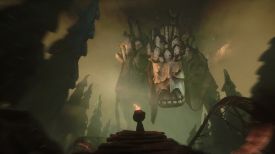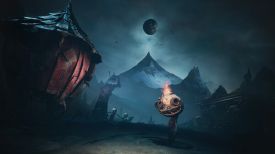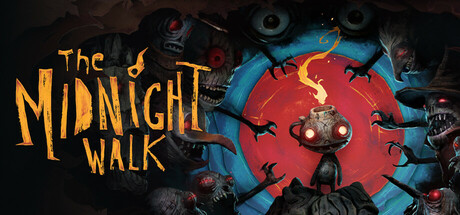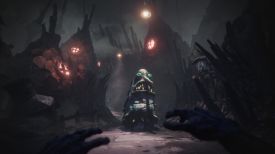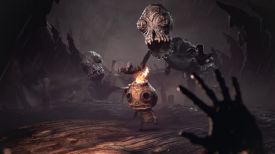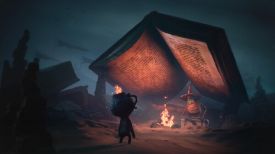|
By flotsam
The
Midnight Walk
MoonHood / Fast Travel Games
I do like stop motion claymation,
so The Midnight Walk was a no brainer to play. I liked even more that it
turned out to be absolutely excellent.
Before I try and tell you things
less emotively, I am going to briefly gush. Everything about this game
sings; the visuals, the soundtrack, the story and the walk itself. It is
sad and beautiful and grim and hopeful. It delighted me and frustrated
me and enthralled me. It sucked me in, and I loved it.
Normal service will now be
resumed.
You play the Burnt One, who
having borrowed some eyes and some ears heads off into the world. A
quest awaits, one leading to Moon Mountain. The journey is littered with
tribulations and stories, and the world is a dark place. Monsters dwell,
shambling and shaking, and you will run and hide and even blink in order
to avoid them. Matches and candles will be an illuminating staple,
sometimes opening new paths, sometimes just providing a bit of cheer,
perhaps even stopping you from freezing to death.
Fire walk with me.
Which it does, once you find
Potboy, a clay companion with a fiery head. Feed him coal, re-light his
fire should it go out. He becomes both your companion and your willing
accomplice, and is pivotal in making your way through the six chapters
that await.
You might play the Burnt One,
but I thought Potboy was almost the centre of things. He will do your
bidding - lighting fires, heating furnaces, wriggling through pipes,
jumping on stuff - but take the time to sit back and just watch him
frolic on his own. He is engaging in his own right, and might also
indicate e.g., when a monster approaches. All hail Potboy!
And then there is Housy, another
companion as house-y as it sounds. It follows along, assuming you can
keep the way clear, and is involved in the happenings more than once. It
is also the repository of the collectible things you might find. I
rarely care about collectibles but here, for various reasons, I wanted
to find them all (I didnít quite). More of that later.
I have already said that
stop-motion animation rings my bells, but the world of the Burnt One is
a visual treat. Tim Burton meets Grim Fandango might be one description,
and there is a nightmarish Grimm-fairytale feel to things. The lumpiness
of the clay gives added texture and almost a vibrancy to the character
modelling, assisted by their colourings. What then helps to make it
shine is all the little bits and pieces. Fire plays a big part, and the
flickering shadows that result is an obvious aspect. Environmental
effects abound, but take the time to observe the things you might
otherwise just walk past. The attention to detail can be extraordinary;
the Vichy-labelled tin that one character is sitting on is just one
example.
I also mentioned monsters, and
there are a few different ones. Something will chase you in the first
chapter, which will put you on notice that this isnít a casual walk.
Some you can just run away from, others can be avoided by creeping and
when necessary hiding (wardrobes are a sign that hiding might be
required), and some can be vanquished just by closing your eyes - what
you canít see might not be able to hurt you. If caught you will die but
will simply respawn in the nearest coffin, and whilst it isnít a hard
game, you will likely have to do some sequences more than a few times,
not just to avoid the monsters but to work out what it is you need to do
in order to move on.
Environmental puzzles are also
part of your journey, many involving fire. Some require the use of a
Matchlock, a kind of hand-held cannon that can shoot matchsticks across
a distance to ignite things you canít otherwise reach. Some involve a
bit of timing e.g., do some stuff before other stuff burns out/finds
you/etc. and closing your eyes and following sounds are an element in
others. Finding things isnít limited to collectibles; keys are important
but so too are e.g., missing bones and pot shards. There are also a few
out and out puzzles.
You can play with subtitles but
I thought they distracted from the story telling so I turned them off,
and let the impressive voice acting do all the narrative lifting. Much
is revealed through tales told by other characters, both through
cutscenes and direct conversation, as well as by a narrator, but many
collectibles have a roll to play as well.
It was one of the reasons why I
was keen to find them. You can finish the game without them, but they
all provide a degree of added depth to the stories or the lore, and some
have a more obvious narrative quality to them (the Shellphones and the
Murkle Story Reels for instance). There are four different types, and
nearly 60 different individual items, and you will come to recognise the
places they can be found.
Very helpfully given their
number, they are archived and stored inside Housy, and the way they are
displayed and presented helped make them a compelling feature. More than
that, you will find things that can best be appreciated (e.g., playing
one of the vinyl records) or indeed appreciated at all (viewing the
Murkle reels) during the calmness of being inside Housy. You will also
be able to ascertain in which chapter any missing item can be found.
It's worth mentioning that the
Murkle reels are part of a single whole, telling a tale about who took
the sun away. It is relevant to the bigger goings on, and how many of
the 15 reels you find will determine how complete a tale you can reveal.
As I said though, finding them is not necessary in order to finish the
game.
You can visit Housy anytime from
the menu, and at other times from within the game. Donít pass up the
opportunity.
The soundtrack I usually turn
right down but here I left it turned up, as its orchestral tones (be
they quiet and almost calming, or brooding and frenetic) both
underpinned and amplified the endeavours. Ambient sound is as good as
the rest of the game, and taken as a whole, it demands to be played in a
dark room using headphones. It isnít a scary game, but it can get a bit
tense avoiding or vanquishing a creature, and there will likely be a
jump-scare or two.
Each of the chapters has its own
tale to tell (e.g., The Tale of the Loathsome Molgrim, The Tale of the
Craftsmanís Heart) but they felt like a connected whole. The final
chapter will see you at Moon Mountain, where you have a choice to make,
and there are two endings depending on that choice. Conveniently, having
seen your original ending, you can just choose Ďresumeí from the menu to
generate the different ending.
You canít save at will but it
does save fairly regularly, and if you die and respawn and find you need
to replay a short portion to get back to where you were, you will still
have any collectibles you found before your demise.
It plays in the first person and
predominantly uses the keyboard (the mouse steers your character, the
keyboard does everything else). A little icon will be generated at a
hotspot, along with an indication of the relevant keyboard key. Whilst
you can examine and even equip items in your inventory, I found that
just having an item caused it to be used. About the only grumblement I
had was that mapping the keys was supposed to be do-able but wasnít
possible.
It took me a bit over 12 hours
and I had a ball from beginning to end.
I played on:
OS:
Windows 11, 64 Bit
Processor: Intel i7-9700K 3.7GHz
RAM:
Corsair Dominator Platinum RGB DDR4 32GB
Video
card: AMD Radeon RX 580 8192MB
GameBoomers Review Guidelines
August 2023
design copyright© 2023
GameBoomers
Group
 GB
Reviews Index GB
Reviews Index |
